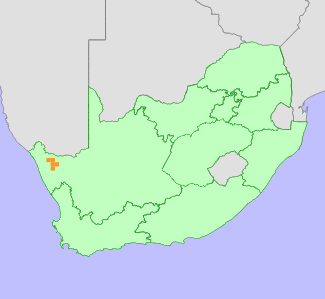|
Scientific Name | Conophytum ectypum N.E.Br. subsp. brownii (Tischer) S.A.Hammer |
Higher Classification | Dicotyledons |
Family | AIZOACEAE |
Synonyms | Conophytum brownii Tischer, Conophytum ectypum N.E.Br. subsp. ectypum var. brownii (Tischer) Tischer |
National Status |
Status and Criteria | Endangered A3c+4d |
Assessment Date | 2021/11/26 |
Assessor(s) | A.J. Young, P.G. Desmet, I. Ebrahim, D. Guo, A. Harrower, L. Jabar, L. Knoetze, C. Rodgerson, P.C.V. Van Wyk & N.N. Mhlongo |
Justification | This succulent is endemic to the Northern Cape province of South Africa with an extent of occurrence (EOO) of 19,910 km2 and area of occupancy (AOO) of 132 km2. The population is in decline due to the illegal ornamental succulent plant trade, with collection likely to increase as there has been a dramatic increase in the number of species and volume of plants targeted since 2019. The continued threat of illegal collection is therefore regarded as very high for this particular taxon and a decline of up to 75% of the population is likely within the next three generations (90 years). Anthropogenic climate change is a major threat to this species. Modelling of climate change impacts is predicted to result in an average loss of 52% of suitable bio-climatic habitat by 2080 under likely CO2 emission scenarios (RCP 2.6). It therefore qualifies as Endangered under criteria A3 and A4. |
Distribution |
Endemism | South African endemic |
Provincial distribution | Northern Cape |
Range | This succulent is endemic to a small area in the Northern Cape province of South Africa. |
Habitat and Ecology |
Major system | Terrestrial |
Major habitats | Succulent Karoo |
Description | The plants are found in both the Richtersveld and the Namaqualand Hardeveld bioregions of the Succulent Karoo biome where they receive winter rainfall. They primarily grow in relatively flat areas amongst fine quartz stones or in cracks and crevices amongst larger quartz blocks. This succulent has a generation length of 30 years. It is expected to be sensitive to the impacts of climate change as it does not disperse and while adapted to arid conditions, is dependent on limited seasonal rainfall. Species in the genus are sensitive to long periods of drought. Drought related mortality has been observed for other closely related taxa within the genus. |
Threats |
| This succulent is currently threatened by illegal collection for the international trade in ornamental succulents. This is likely to increase in future as there has been a dramatic increase in the number of species and volume of plants targeted since 2019 and the main locations are in close vicinity to human habitation.
There is no decline in habitat quality for this taxon as inferred by changes in vegetation cover determined from changes in Enhanced Vegetation Index (EVI) between 1984 and 2018 using Landsat data (Venter et al. 2020). While it is not possible to model the response of this taxon to climate change due to its restricted distribution, the average loss to climate change for 15 more widely distributed Conophytum species occurring within the same region is used as an indication of likely impact to this taxon. Climate models for the likely emission scenarios where emissions stay at present day levels (RCP 2.6) (Hausfather and Peters 2020) and worst case scenarios where emissions continue to increase during the 21st century (RCP 8.5) indicate that there will be a loss of suitable bioclimatic envelope of between 72% and 99% by 2080 for this taxon. However, as this taxon occurs in a sheltered habitat and is found across several vegetation units it is expected to have a level of resilience to climate change and the expected population loss is reduced by 20% to 52%. Species in this genus have limited dispersal ability and migration to suitable habitats elsewhere is regarded as highly unlikely. |
Population |
There are no formal estimates of population size for this succulent but the number of mature individuals is likely to be well in excess of 10,000. The population is in decline due to illegal collection to supply the international trade in ornamental succulents, with several hundred plants being removed since 2019. A decline of 75% of the population is expected by 2109 (three generations; 90 years).
|
Population trend | Decreasing |
Assessment History |
Taxon assessed |
Status and Criteria |
Citation/Red List version | | Conophytum ectypum N.E.Br. subsp. brownii (Tischer) S.A.Hammer | Least Concern | Raimondo et al. (2009) | |
Bibliography |
Hammer, S. 2002. Dumpling and his wife: New view of the genus Conophytum. EAE Creative Colour, Norwich.
Hammer, S.A. 1993. The genus Conophytum: A conograph. Succulent Plant Publications, Pretoria.
Hausfather, Z. and Peters, G.P. 2020. Emissions - the 'business as usual' story is misleading. Nature 577(618-620).
Opel, M.R. 2004. The rediscovery of Crassula alcicornis. Haseltonia 10:38-40.
|
Citation |
| Young, A.J., Desmet, P.G., Ebrahim, I., Guo, D., Harrower, A., Jabar, L., Knoetze, L., Rodgerson, C., Van Wyk, P.C.V. & Mhlongo, N.N. 2021. Conophytum ectypum N.E.Br. subsp. brownii (Tischer) S.A.Hammer. National Assessment: Red List of South African Plants version 2024.1. Accessed on 2025/11/07 |
 Comment on this assessment
Comment on this assessment


